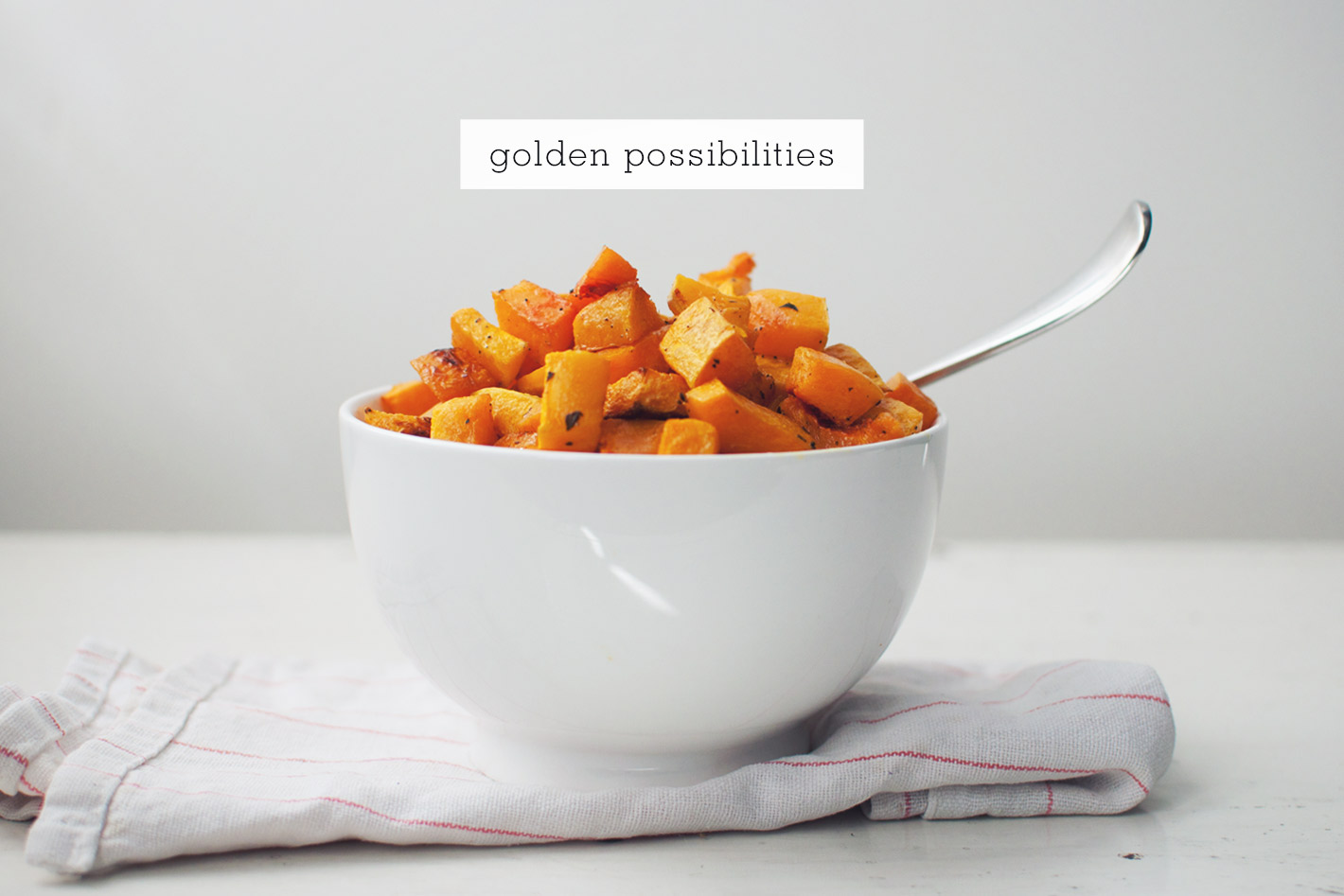
Quitting your job is like roasting butternut squash cubes. It can be darn intimidating. It’s odd and different. Risky. Awkward to handle. And EVERYONE else makes it look so deliciously golden and easy.
If you are here reading this, then you either: 1) are really curious about how to quit your job (or how I did); and/or 2) are ready to make some golden butternut squash cubes. Either way, get ready to take a risk. What you learn along the way will be golden, no matter the outcome.

 We won’t go too deep into our story as co-creators of this project (Wake the Wolves), because you can read more about it here and in our first book, “Kale. All Day. Err Day.” We will tell you that what you envision for your life, most likely won’t be exactly where you end up.
We won’t go too deep into our story as co-creators of this project (Wake the Wolves), because you can read more about it here and in our first book, “Kale. All Day. Err Day.” We will tell you that what you envision for your life, most likely won’t be exactly where you end up.
If you want to quit your job (or roast that squash), the first step is to face that desire dead-on. Look at that odd shaped thing that you’ve been avoiding and ask yourself: “1) what do you see for your career path if you stay where you are?; and 2) what do you see for your career path if you leave?” Do you see the potential to make golden cubes that get better over time? Or are you so scared that all you see is a failed bowl of mush that will never look like the photos in a magazine? Your outlook (about life, career, butternut squash, etc.) WILL impact your experience.

Your task
Take out a blank piece of paper and write down (in no particular order) what your fears are. Putting it on paper may help you see the obstacles in black and white, then you can determine action steps that can mitigate the risks. Do you fear failure? Not making money? Not knowing enough about a particular topic? The purpose of this task is to get it out of your head so you can use it as a leaping pad.
Roasting Butternut Squash – Step 1
Whenever cutting any vegetable that’s round or odd-shaped, the first task is to trim an edge (or edges) to create a flat, sturdy surface for future cuts. Simply place the squash on its side and firmly hold the skinnier side of the butternut squash with one hand as you use a sharp knife to remove the bottom. Rotate the squash and trim the top off. Use a peeler to remove the outside skin.
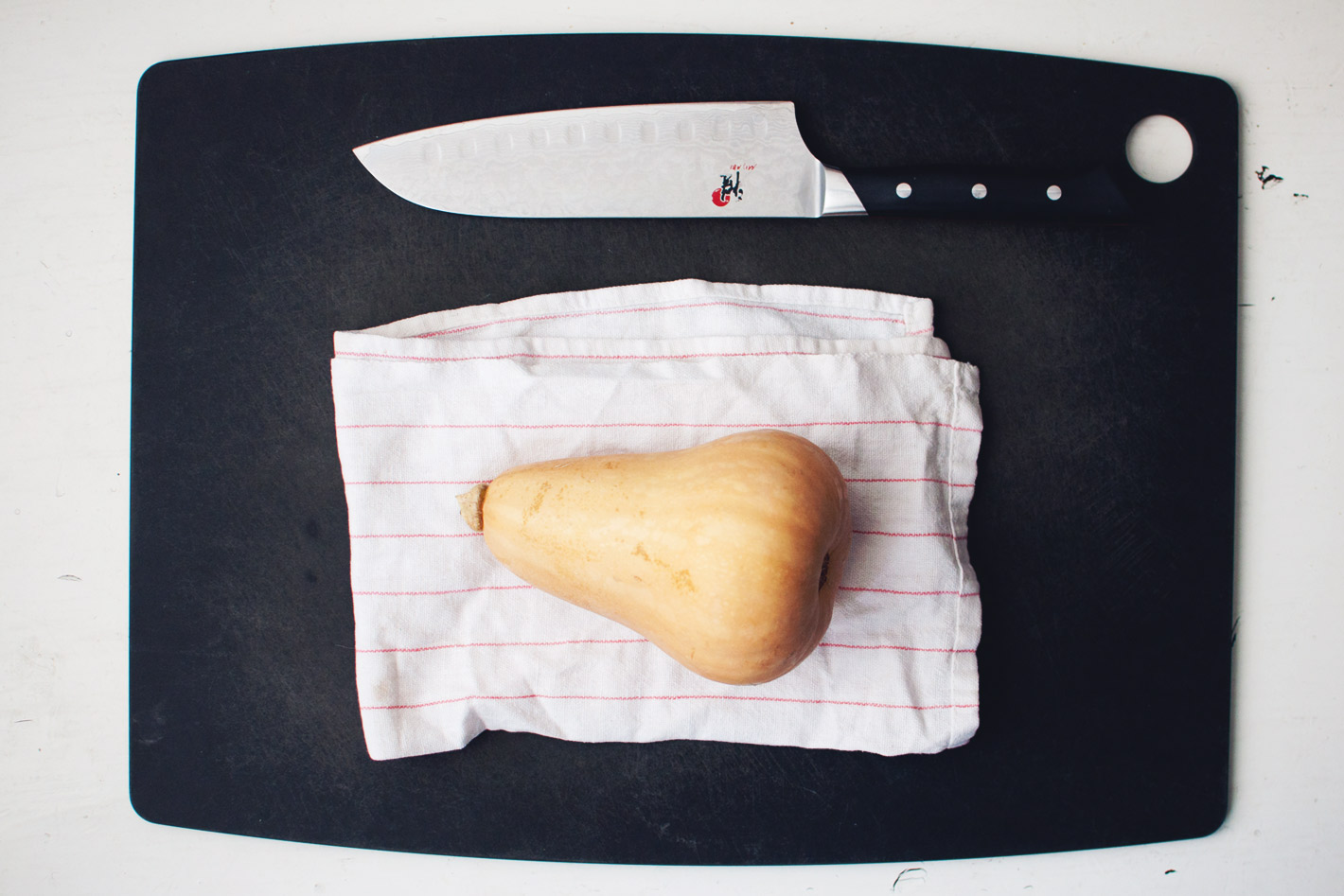
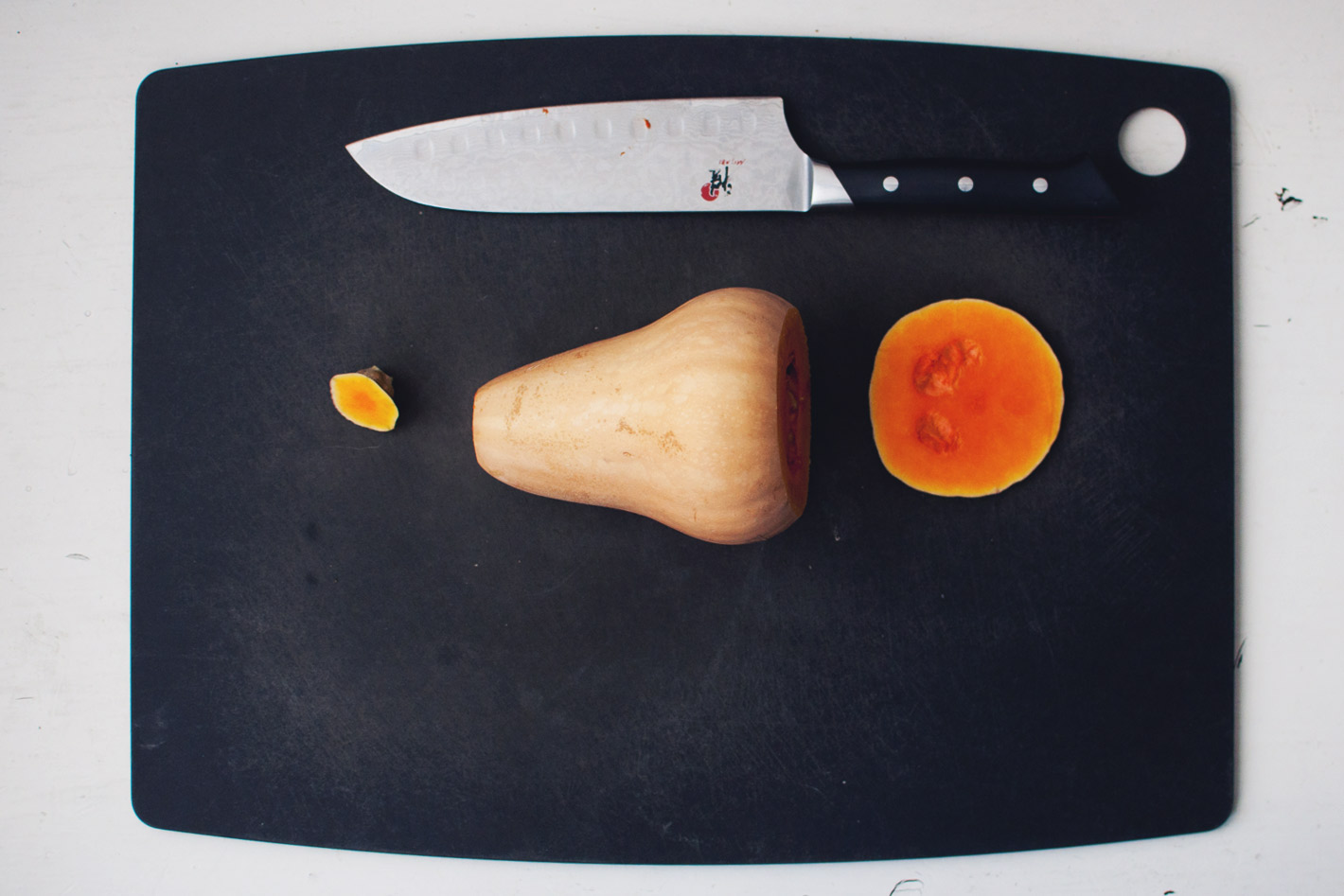
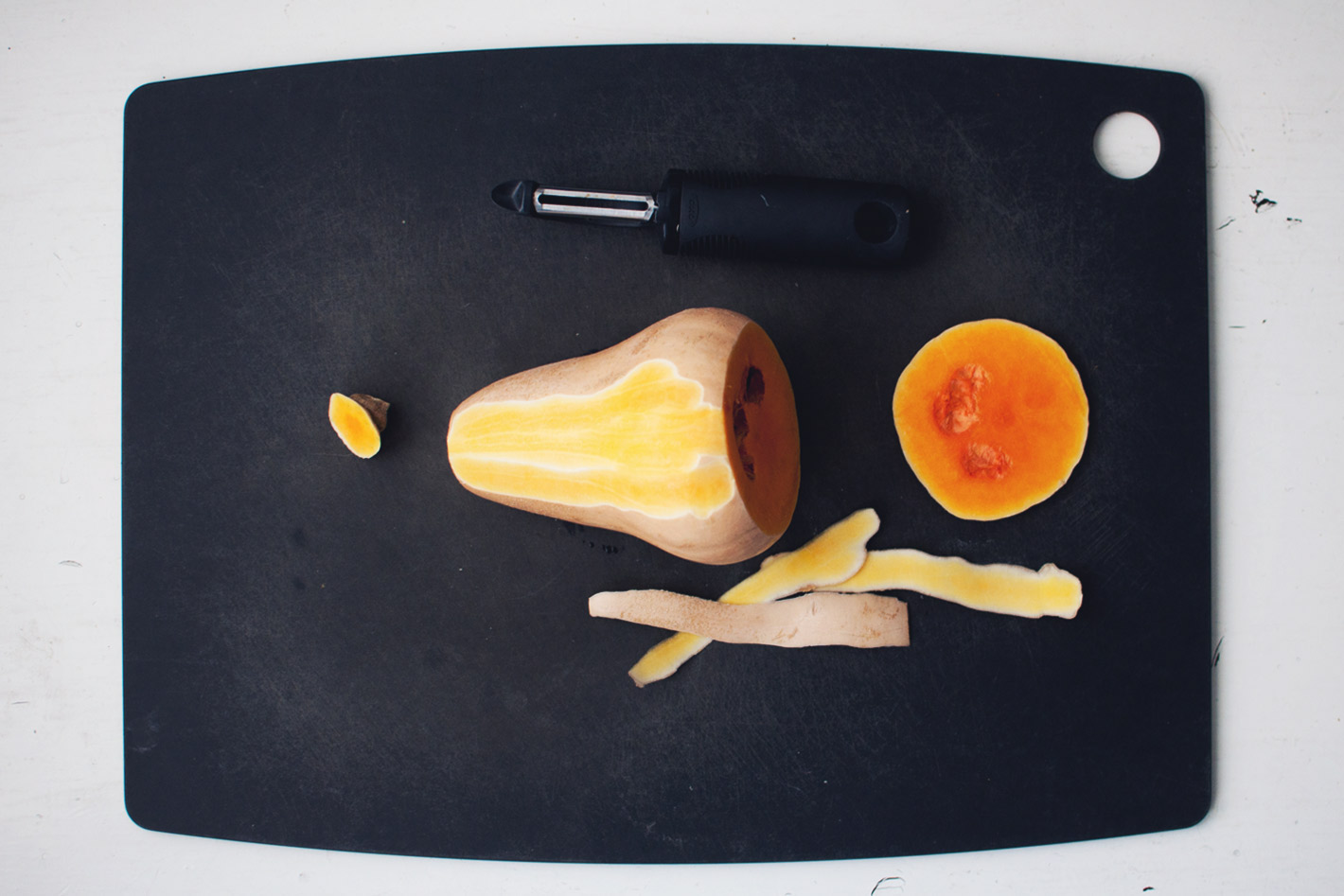

 Your purpose is not your career title, nor your role as a dad, or a girlfriend, or a daughter. Your purpose is simply what YOU CHOOSE to make your life be about in this world, NO MATTER where you are. It can also be translated as what is left behind when you pass away – your legacy. For us, we say: “Our purpose is to help people see their fullest potential in leading healthy, honest lives through dialogue, design, and food.”
Your purpose is not your career title, nor your role as a dad, or a girlfriend, or a daughter. Your purpose is simply what YOU CHOOSE to make your life be about in this world, NO MATTER where you are. It can also be translated as what is left behind when you pass away – your legacy. For us, we say: “Our purpose is to help people see their fullest potential in leading healthy, honest lives through dialogue, design, and food.”
I didn’t necessarily need to quit my job and start a few businesses to make that happen, but I did. Perhaps that’s what you want to do. OR, perhaps what you are craving is simply re-identifying what your purpose is and grounding yourself by aiming at that every day, no matter where you are.
Your task
Write down what you think your purpose is by using this formula: “My purpose is to __________ through/by doing _______________.” Say it out loud. Pin it up. Go one whole day with that purpose as the root of all your choices.
Roasting Butternut Squash – Step 2
With a solid, sturdy base, you are now ready to aim the wider part of the knife’s blade right down the middle of the butternut squash. Your clear intention is to split it in half so you can enjoy what it has to offer (ahem…like life)! Don’t forget that. After it’s split in half, use a spoon to remove the seeds.
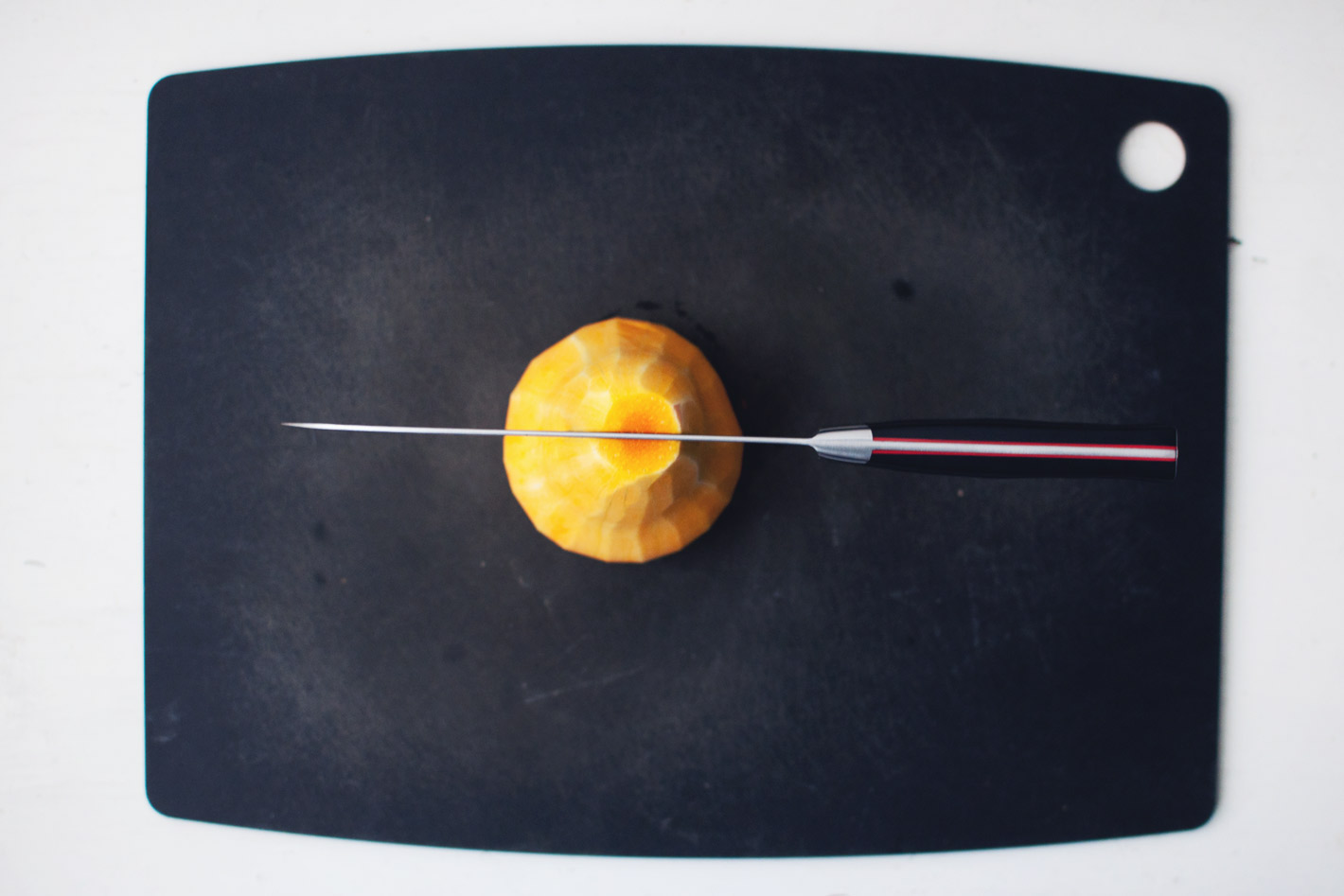
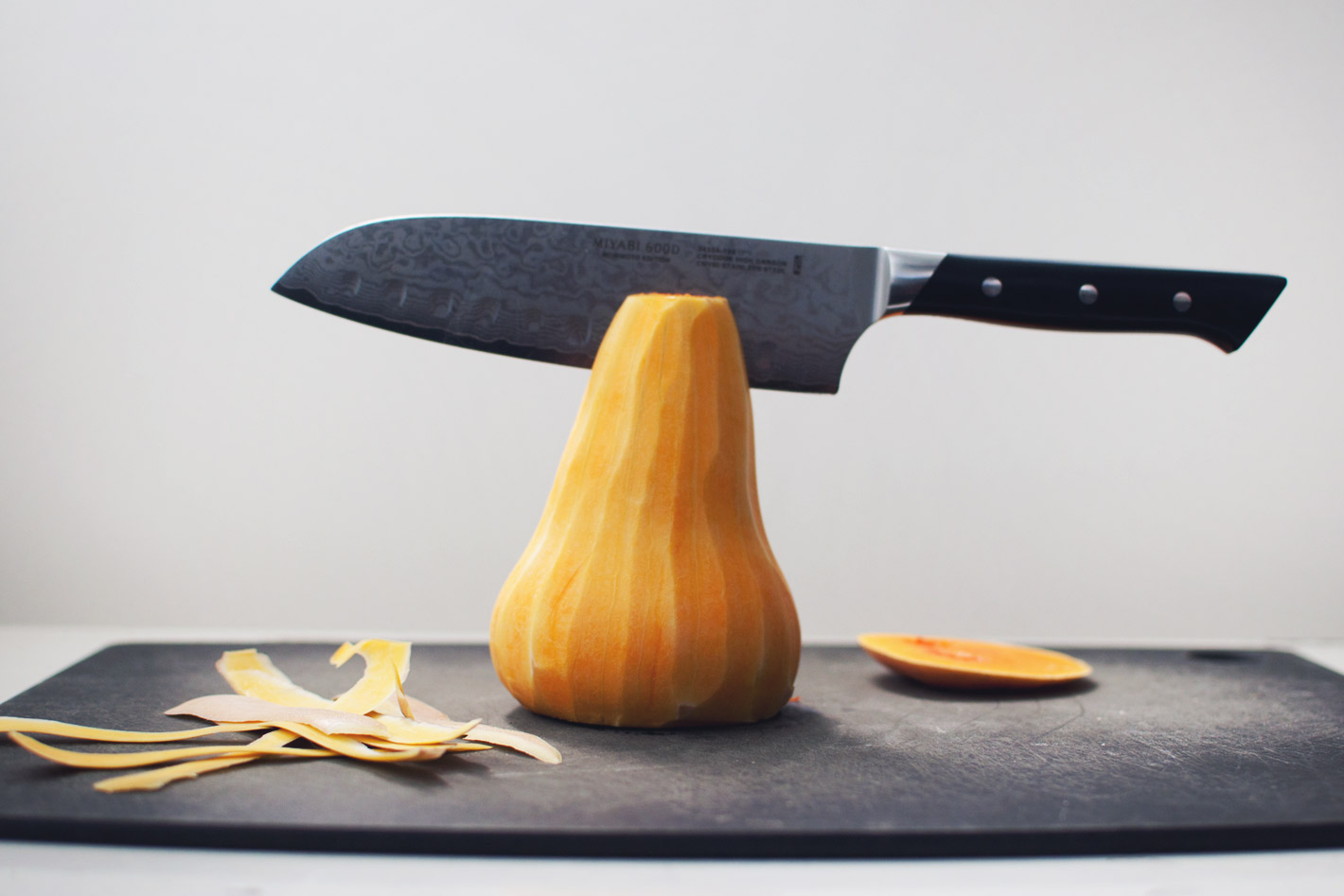
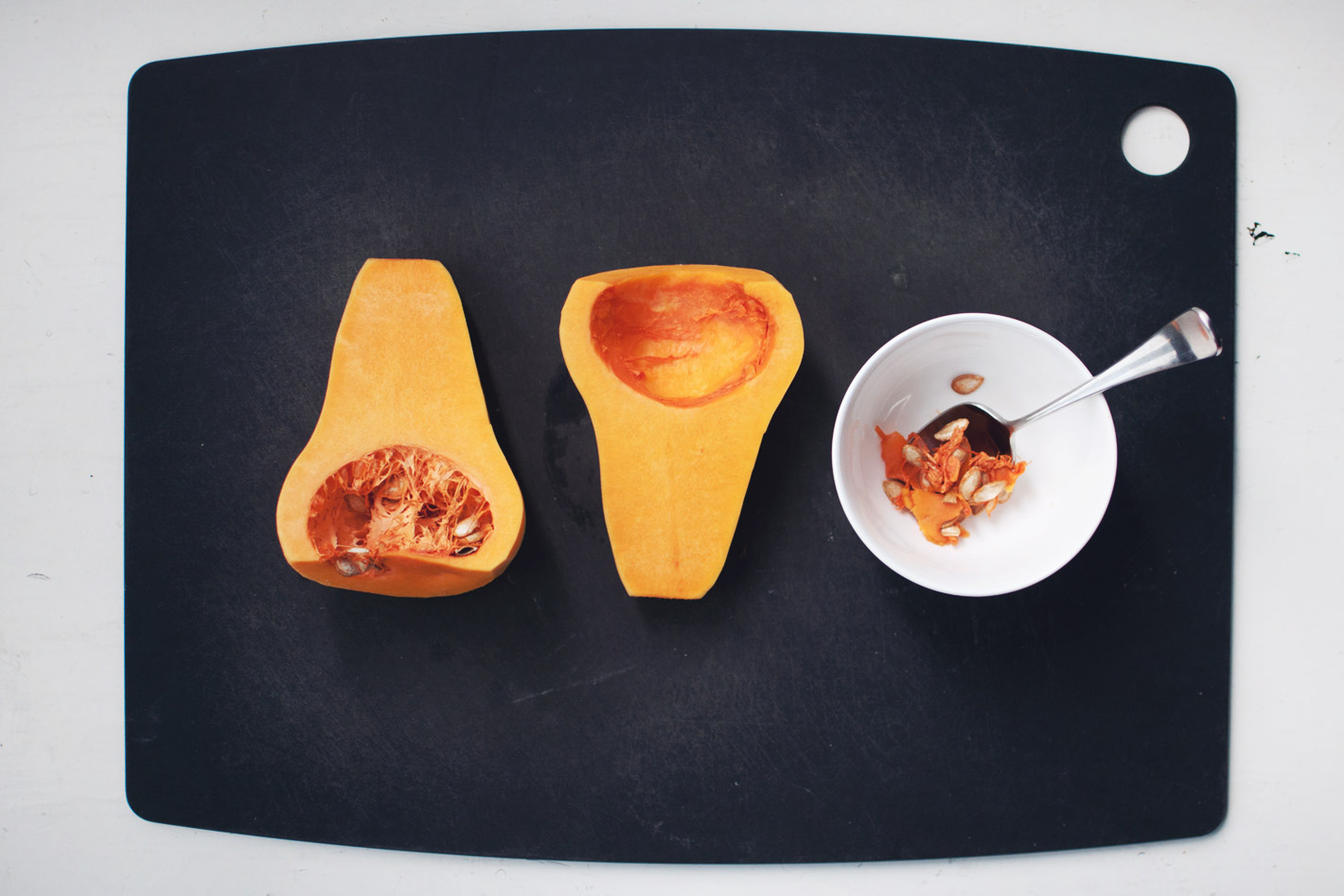
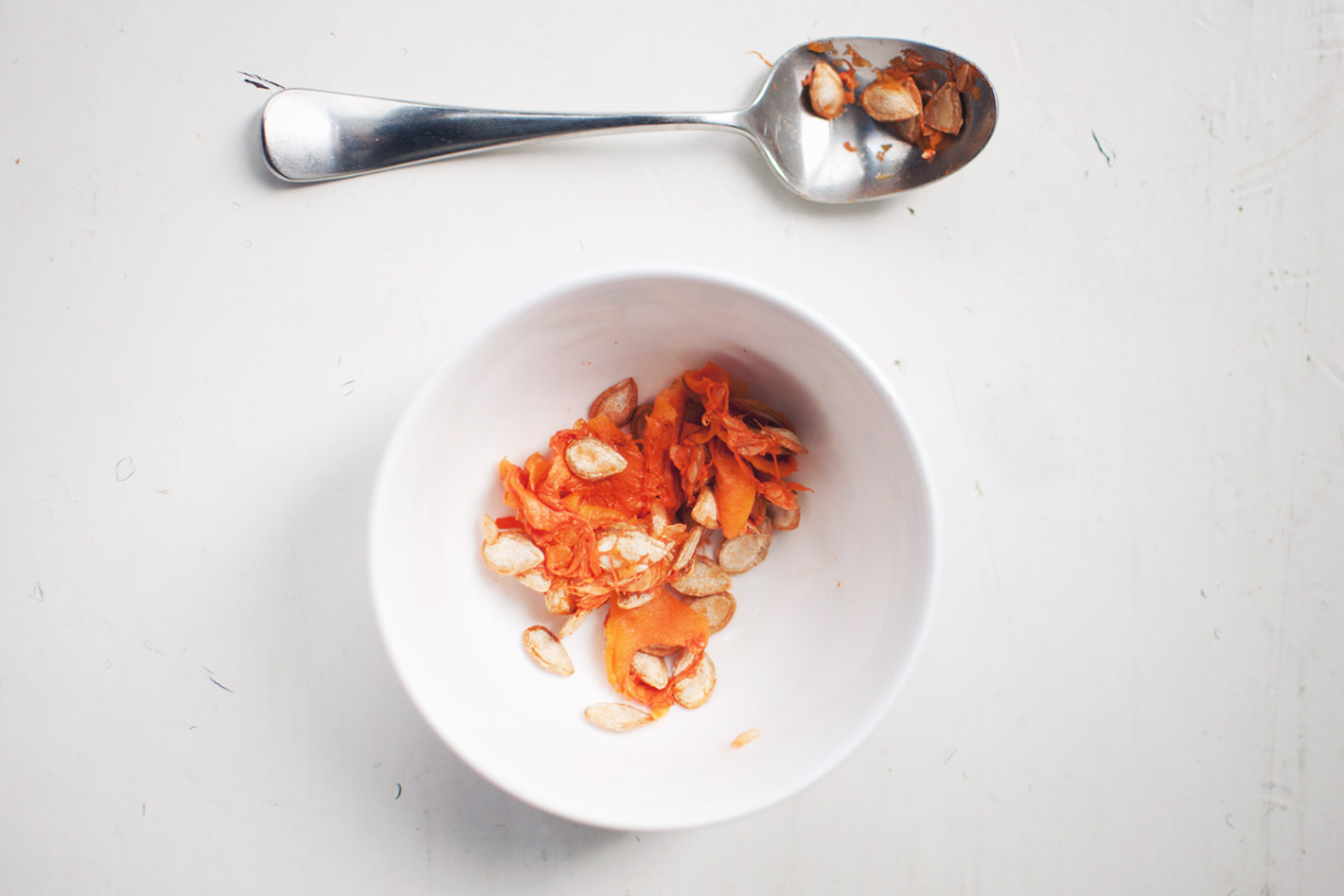

 Have you ever taken an overly ambitious, really big bite of a burger, or a sandwich, or even a big gulp of a milkshake – and then realized that you probably should have taken a slightly smaller bite to avoid the extra sauce dripping down your face, or the brain freeze from the oversized frozen drink? We have.
Have you ever taken an overly ambitious, really big bite of a burger, or a sandwich, or even a big gulp of a milkshake – and then realized that you probably should have taken a slightly smaller bite to avoid the extra sauce dripping down your face, or the brain freeze from the oversized frozen drink? We have.
For me personally, I’ve always eaten baby bok choy veggies at Chinese restaurants without cutting them, and as a result, choked on the stringy fibers. My sisters would scold and tease me every time:)
The choice to quit your job doesn’t have to be an experience of biting off more than you can chew, but it may require you to break it up into chunks. It may mean having multiple discussions with your partner to plan your finances, or working part-time instead of full-time, or going back to school, or getting an internship to see if it’s what you really want to do.
Your task
If you were to “take the leap,” what are 3 things you can do this month to get you out of “thinking mode” and into “experimenting/playing mode?” For example, I went back to school to study holistic nutrition, worked freelance, and then sought a mentor. See step #4.
Roasting Butternut Squash – Step 3
To break your butternut squash up into ¾” chunks, lay each half face down with the rounded edge facing up. Slice each half in half again so the long neck is separate from the lower base. You should now have 4 equal parts. Carefully slice each part into ¾” wide sticks, then cut across the sticks to make ¾” cubes. There may be a few that can use an additional slice if the chunks are too long.
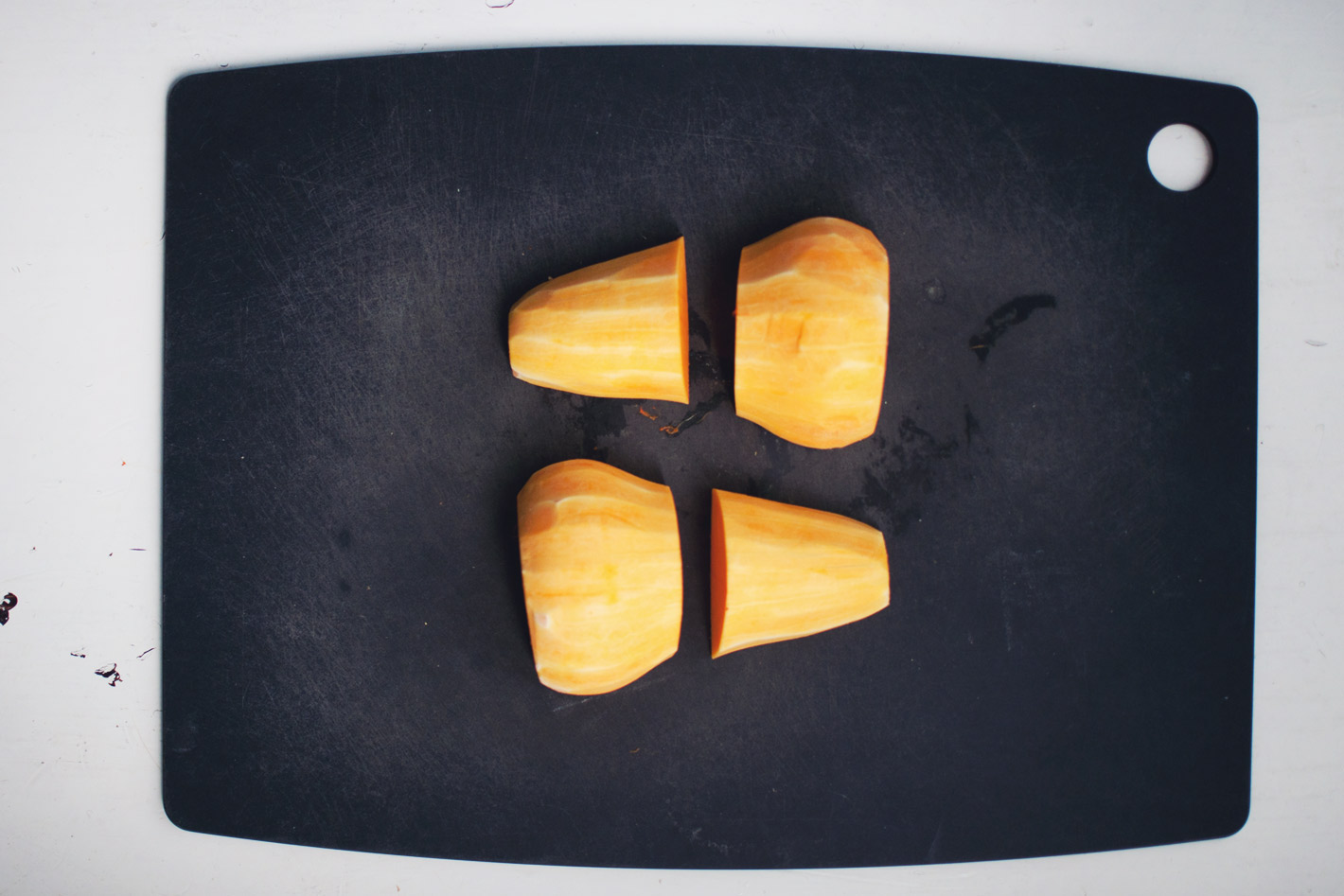
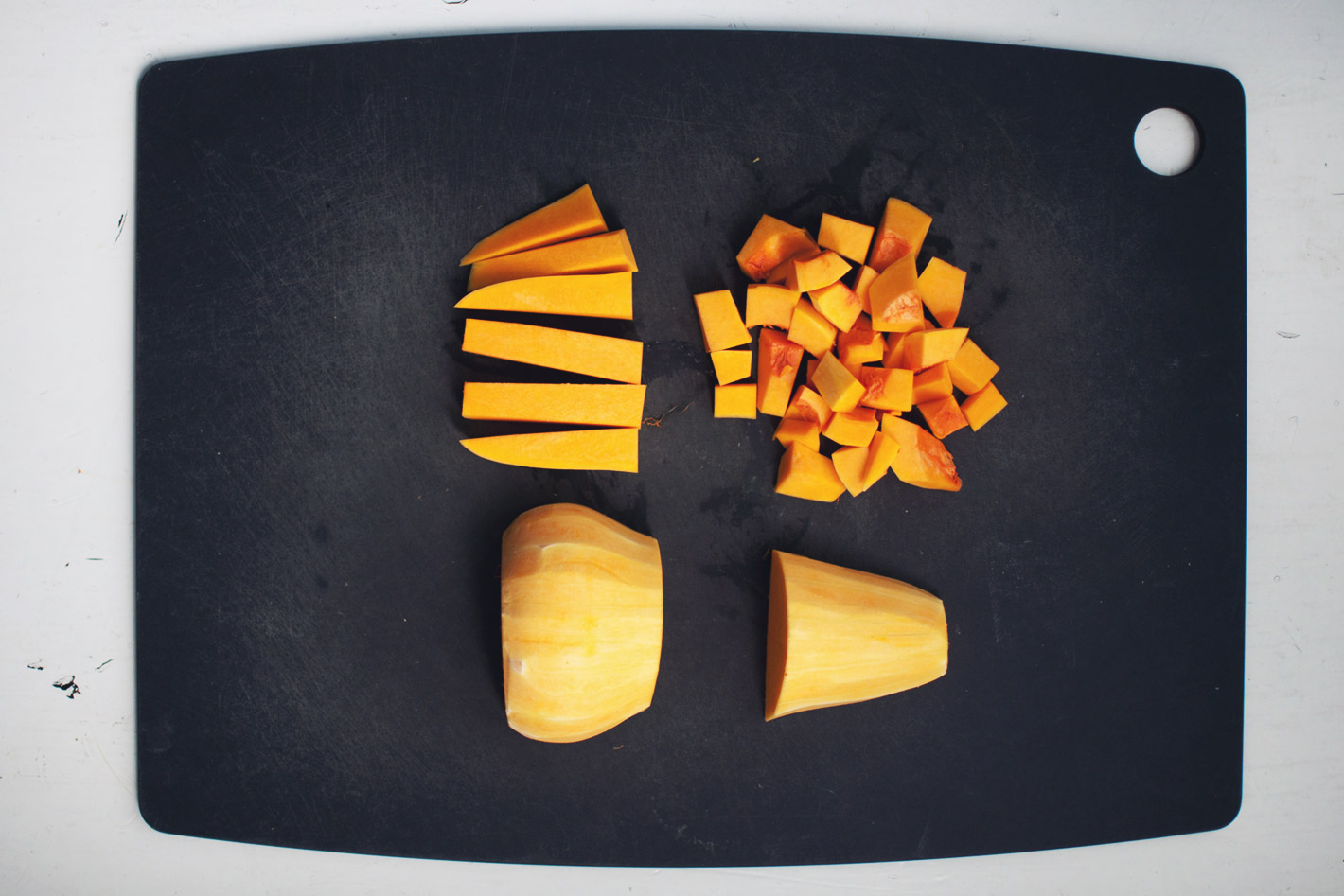

 Asking for help is one thing that doesn’t come easy to me, but in the case of quitting my job, I knew I couldn’t (and still can’t) do it alone. One day at 12am while I was traveling in Japan during my last year in a corporate art director position, I wrote an email to Maxine Siu (co-owner and chef of Plow restaurant in San Francisco). I told her my story and asked if I could work for her (for free) in exchange for her teaching me how to run a food business (which was my original plan). She emailed me and said: “come see me when you’re back in SF” and so I did. I woke up at 4am 1-2x a week (for a year) to work with her for a few hours in the morning, while still carrying freelance gigs and venturing into entrepreneurship. The inspiration and flavor that she added to my life as a woman and business owner made my journey golden. She remains a great mentor, along with the others that have added some pep to my step along the way!
Asking for help is one thing that doesn’t come easy to me, but in the case of quitting my job, I knew I couldn’t (and still can’t) do it alone. One day at 12am while I was traveling in Japan during my last year in a corporate art director position, I wrote an email to Maxine Siu (co-owner and chef of Plow restaurant in San Francisco). I told her my story and asked if I could work for her (for free) in exchange for her teaching me how to run a food business (which was my original plan). She emailed me and said: “come see me when you’re back in SF” and so I did. I woke up at 4am 1-2x a week (for a year) to work with her for a few hours in the morning, while still carrying freelance gigs and venturing into entrepreneurship. The inspiration and flavor that she added to my life as a woman and business owner made my journey golden. She remains a great mentor, along with the others that have added some pep to my step along the way!
Your task
Write down three mentors that you want to connect with. You don’t have to know them personally. Then pick one and write them a letter. When it’s time (you’ll know when), deliver the letter and see what happens. If there’s no response, it just means try again.
Roasting Butternut Squash – Step 4
The “flavor mentor” in the case of roasting your butternut squash is simply 1 tablespoon of coconut oil (melted) for every 3 cups of cubed squash, plus a pinch of sea salt and freshly ground pepper. Of course, feel free to add freshly chopped herbs. Maxine’s cooking inspired me to bring fresh thyme into our kitchen, so we always love a sprinkle of that. Toss all of the ingredients in a bowl, lay it on a cookie sheet (with parchment paper), and roast at 400 degrees for 30 – 45 minutes or until golden and tender. Every so often, use a spatula to turn and flip the cubes for even cooking.
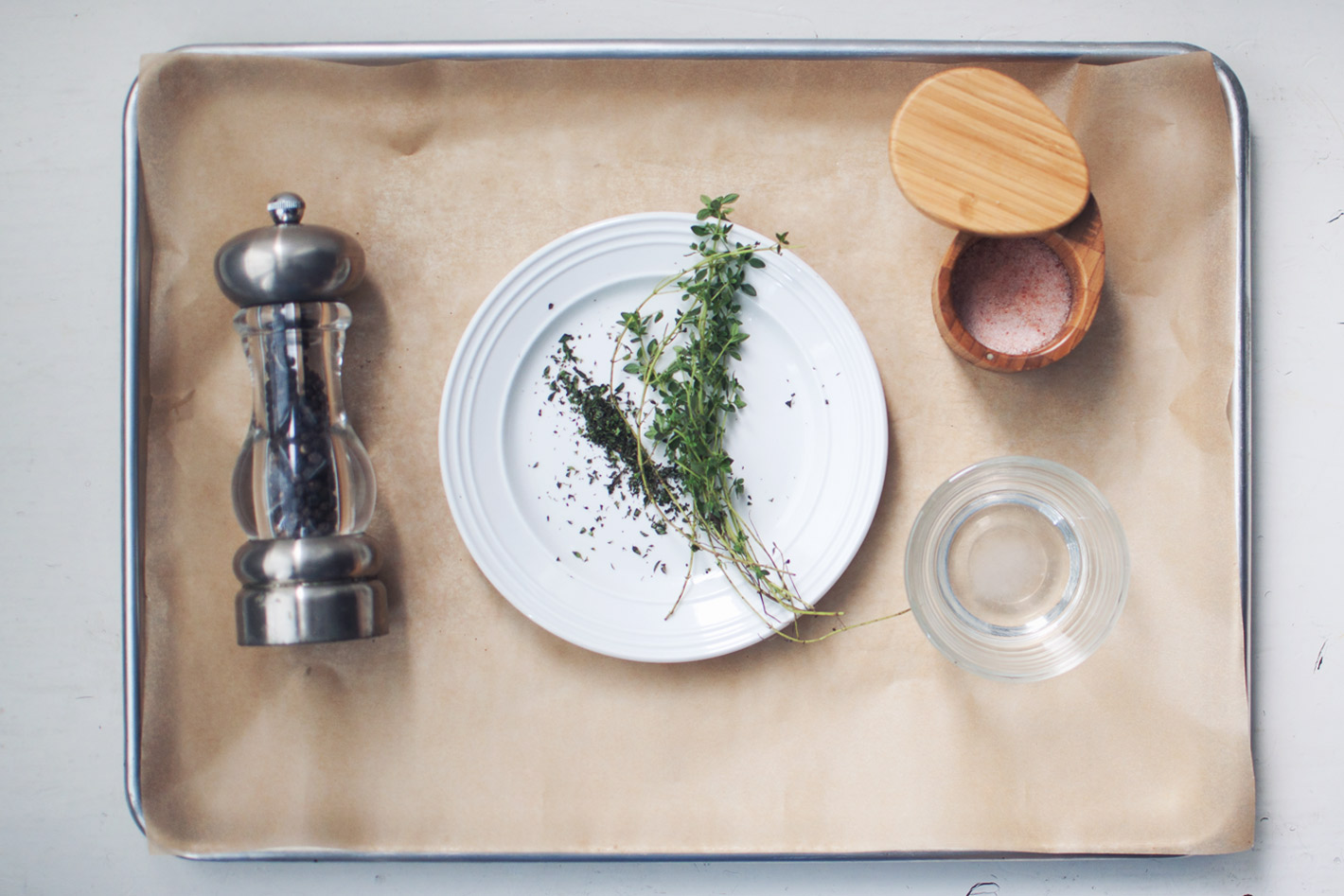
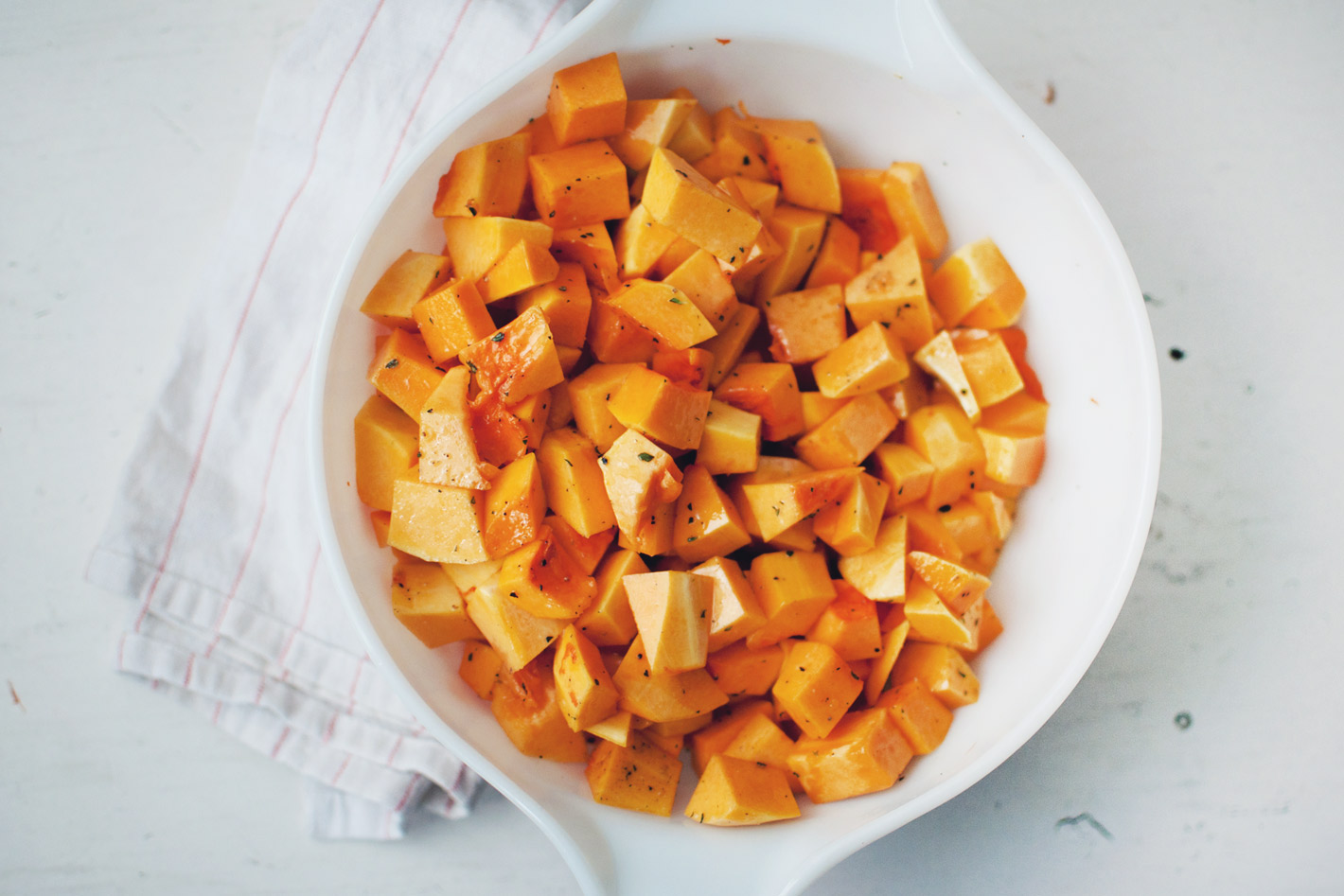

 Beyond learning amazing cooking techniques, Maxine (and her husband Joel) taught me SO MUCH more than how to run a food business. She showed me that it is indeed possible to live a healthy, loving life and work for yourself. She taught me to listen to “my purpose,” that going solo takes LOTS of hard work, that sleepless nights do happen, that spending time with her family is irreplaceable, that her husband makes an amazing biz partner, that her twenties were rough and confusing like mine 😉 and that thirties are better, but forties are great too! She is a blessing. She shared her bowl with me and I encourage you to do the same.
Beyond learning amazing cooking techniques, Maxine (and her husband Joel) taught me SO MUCH more than how to run a food business. She showed me that it is indeed possible to live a healthy, loving life and work for yourself. She taught me to listen to “my purpose,” that going solo takes LOTS of hard work, that sleepless nights do happen, that spending time with her family is irreplaceable, that her husband makes an amazing biz partner, that her twenties were rough and confusing like mine 😉 and that thirties are better, but forties are great too! She is a blessing. She shared her bowl with me and I encourage you to do the same.
Your task
We often think we don’t have enough to share, but we always do. If you are stuck, do something to share a bit of yourself with someone else. The act in and of itself will remind you what your purpose is. You can share a story, or something you make, or a listening ear…or maybe a delicious bowl of golden, roasted butternut squash.
Roasting Butternut Squash – Step 5
Carefully remove the baking sheet from the oven and use a spatula to serve them in a beautiful bowl to share with fam & friends. Sprinkle with a bit more sea salt, pepper, or fresh herbs if you’d like. They taste great on their own, or add them to green or grain salad, puree them in soups, or stir fry with other veggies.
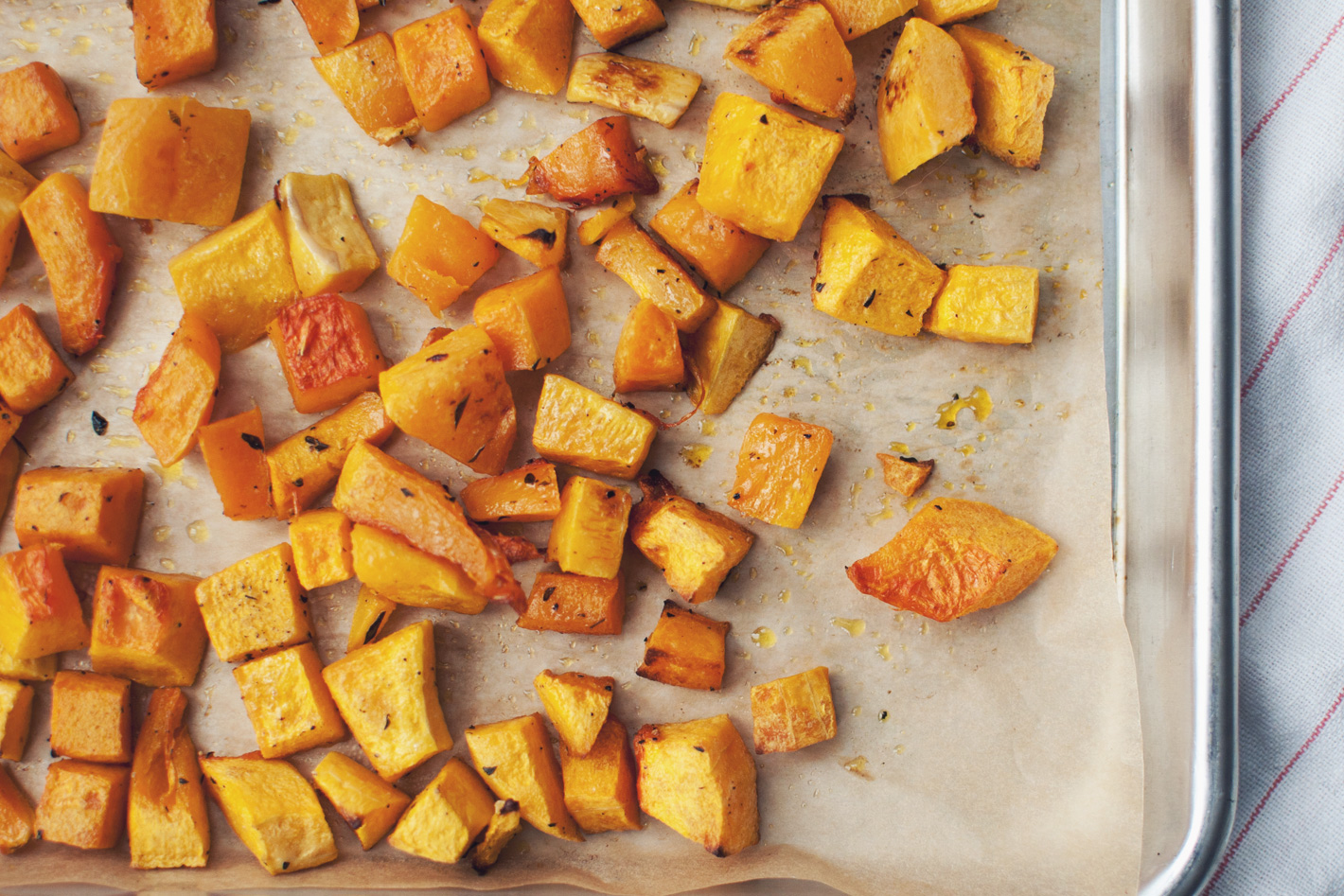
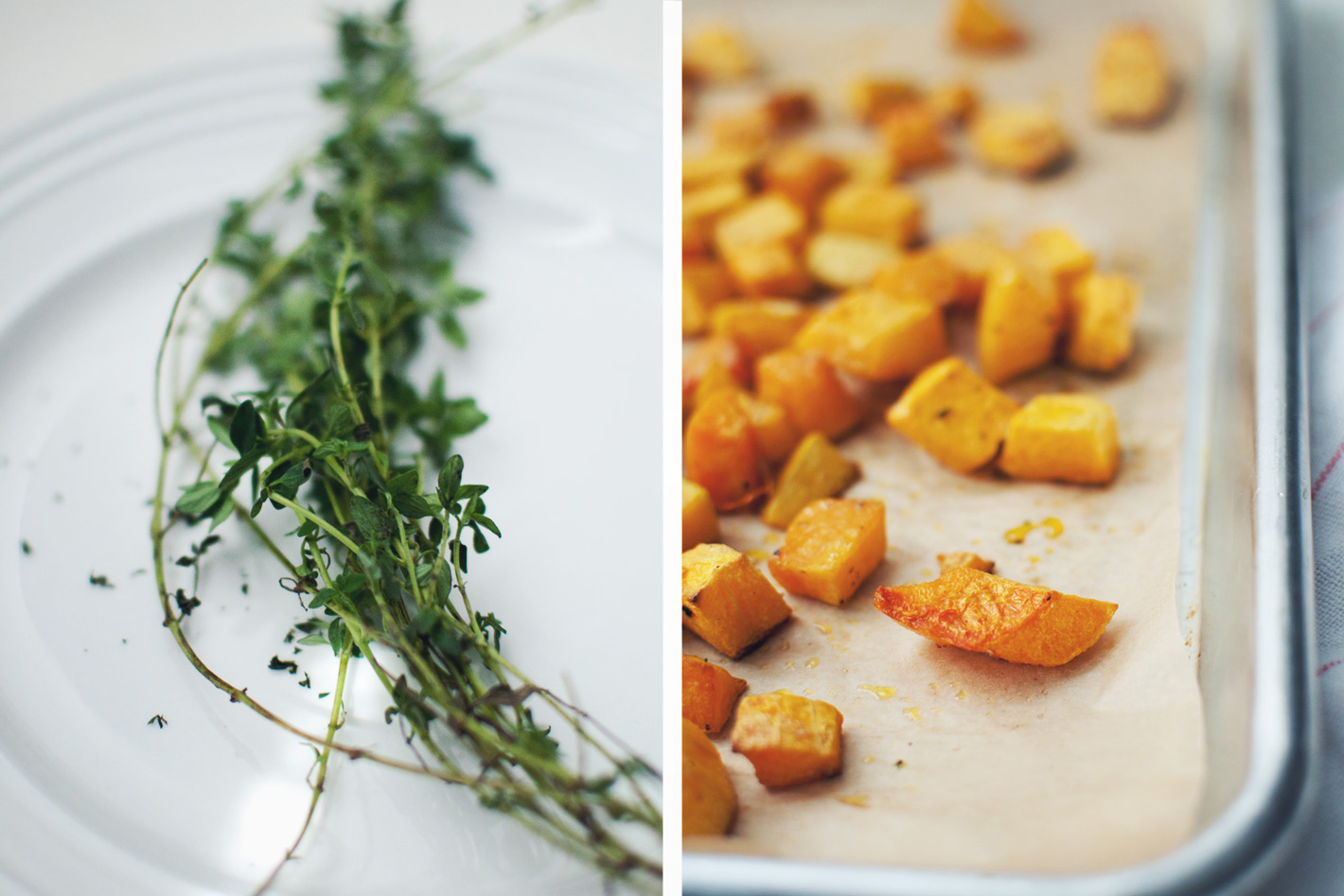

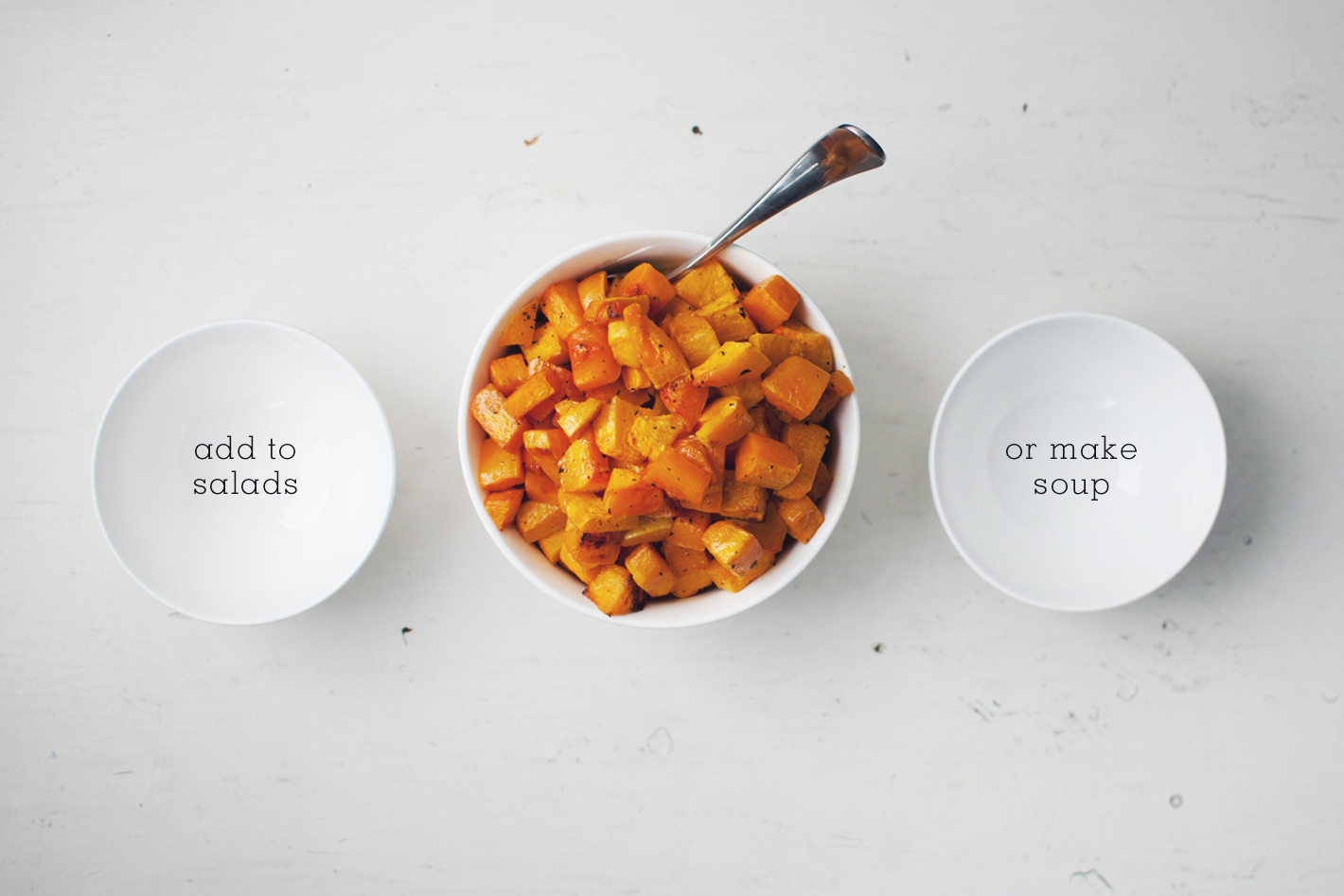
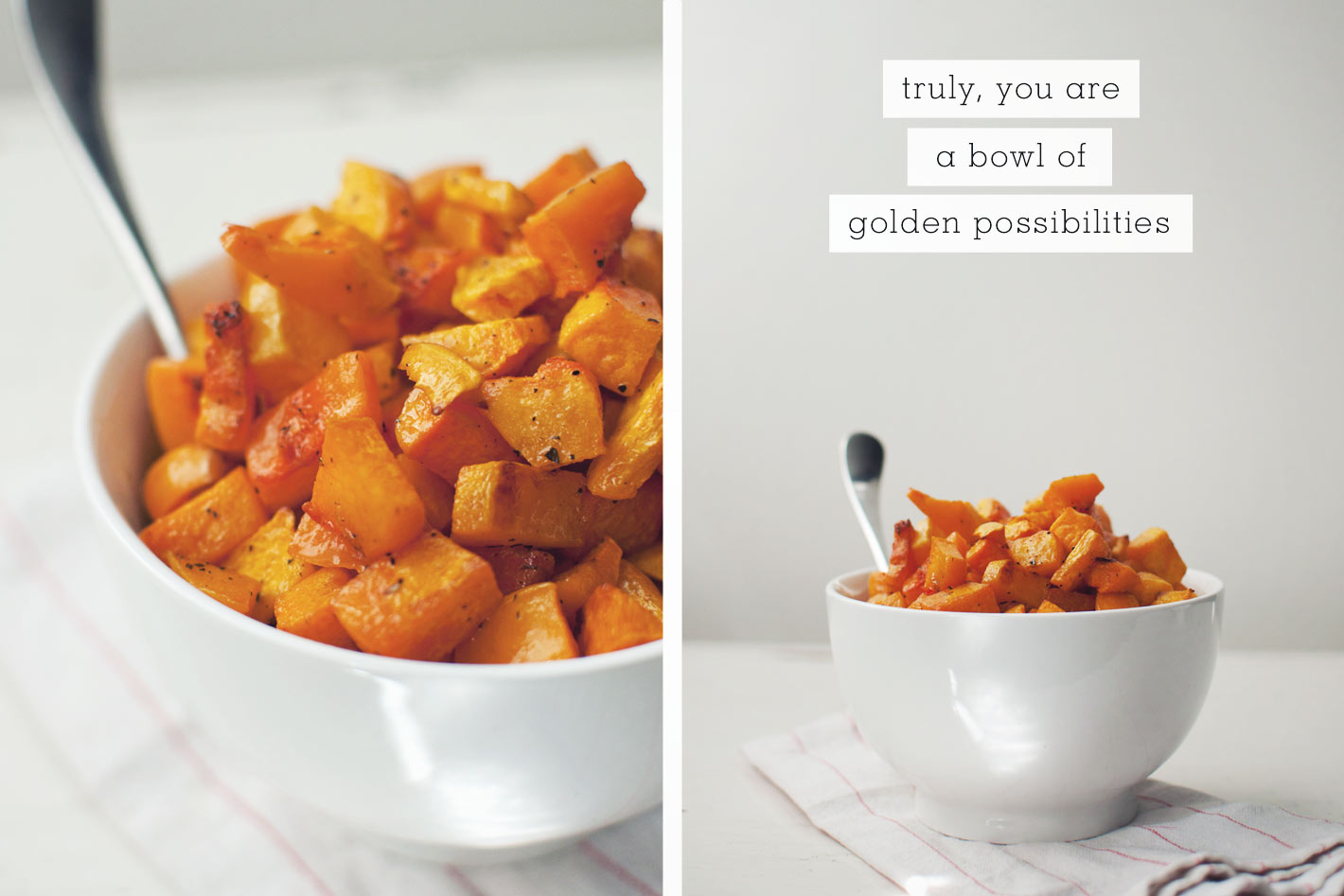
The steps in this post are simply to share that LIFE (and roasted butternut squash) is possible. As I’ve been flying solo for a few years, I’ve learned A TON! And the most helpful, grounding reminder is that “my purpose” can be manifested in so many ways, and when that stops, that’s when I wake up and say: “it’s time for change.”
Ingredients
2 small to medium butternut squash (makes about 6 cups, cubed)
2 tablespoons coconut oil, melted (or 1 tablespoon if you are only roasting 1 squash)
Sea salt and pepper to taste
Chopped fresh herbs (like thyme and rosemary) are optional
Steps
-
Preheat the oven to 400 degrees F and line a baking sheet (or 2) with parchment paper.
-
Place the squash on its side and firmly hold the skinnier side of the butternut squash with one hand as you use a sharp knife to remove the bottom. Rotate the squash and trim the top off. Use a peeler to remove the outside skin.
-
Sit the squash upright and it should be nice and sturdy. Aim the wider part of the knife’s blade right down the middle of the butternut squash. Use a spoon to remove the seeds.
-
Lay each half face down with the rounded edge facing up. Slice each half in half again so the long neck is separate from the lower base. You should now have 4 equal parts. Carefully slice each part into ¾” wide sticks, then cut across the sticks to make ¾” cubes. NOTE: There may be cubes that can use an additional slice if the chunks are too long.
-
Toss the cubes, melted coconut oil, sea salt, pepper, and herbs in a bowl, then spread on a parchment-lined cookie sheet. Roast at 400 degrees for 30 – 45 minutes or until golden and tender. Every so often, use a spatula to turn and flip the cubes for even cooking.
-
Carefully remove the baking sheet from the oven and use a spatula to serve them in a beautiful bowl. Re-season if needed.
Serves 4 – 6 (as a side)
Kale. All Day. Err Day.

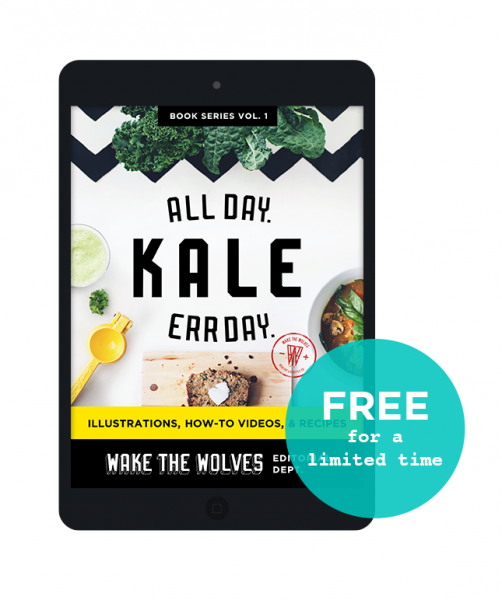
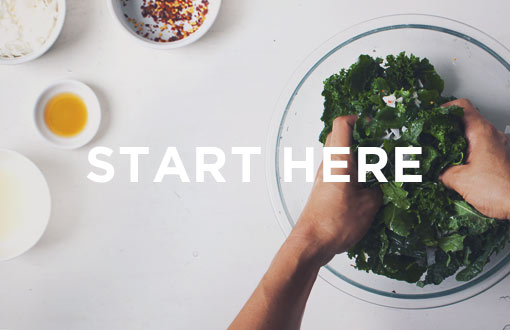

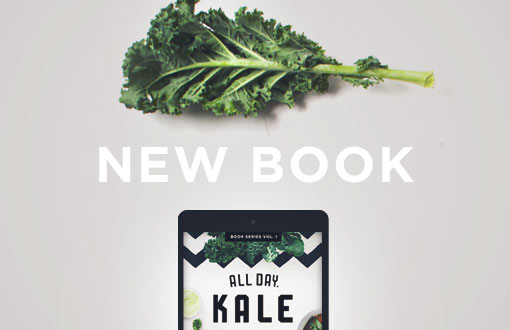
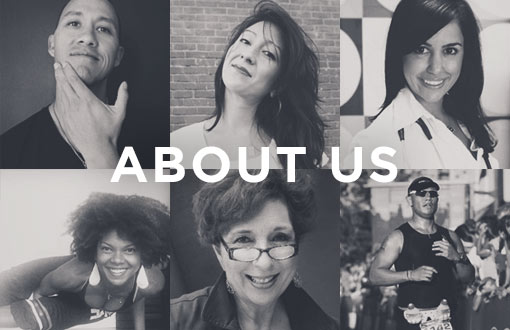



Thanks for Sharing this great post!
You are mighty welcome Barbara! Thanks for reading 🙂
Girls, this post was the perfect mix of beautiful photography, education, laughter and “scratch your head” kinda moments. As a rookie blogger (and full time employed Dietitian) I’ll have to walk through the exercises you mention above. I’ve got the perfect spaghetti squash to help. 😉
Happy Friday!
Hi Nita — thanks so much for the super sweet note. Somehow merging food with life just works, right? Happy Friday right back at ya!
-steph
DAMN
that was a DAMN good article
Thanks so much for reading it…then taking the time to write a comment! BOOM! LOVIN THIS COMMUNITY!
Good Sane Advice!! Happy Squash, Happy Life!!